Offshore Wind Energy Market Size
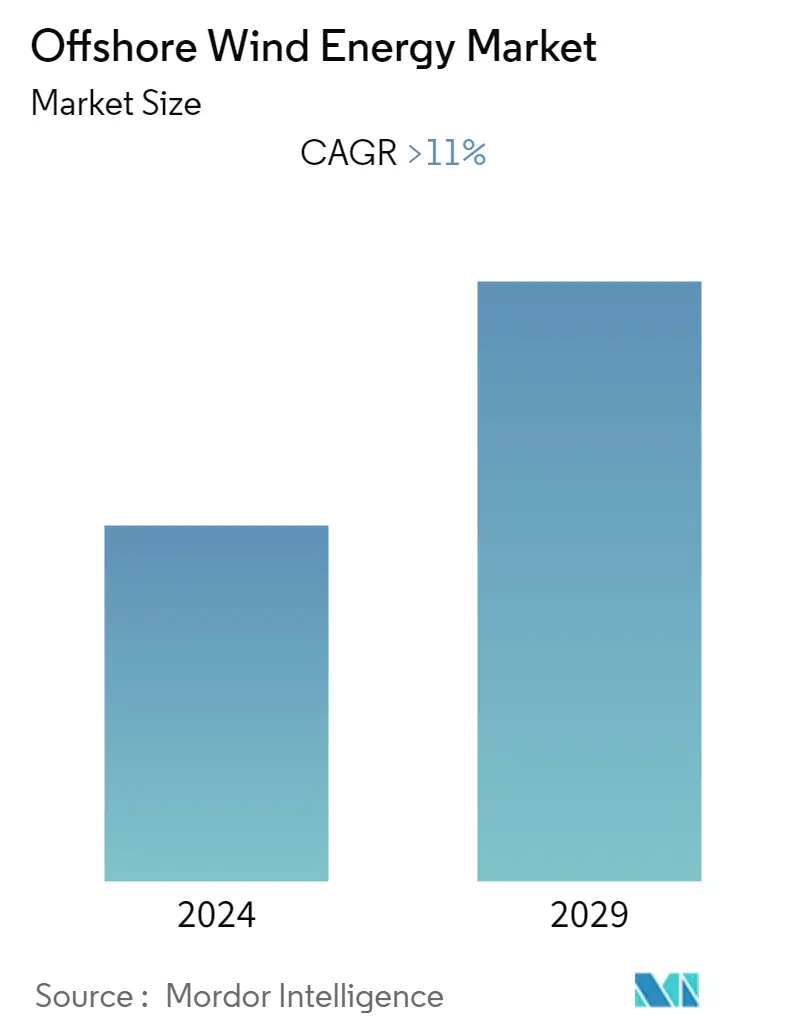
| Study Period | 2020 - 2029 |
| Base Year For Estimation | 2023 |
| CAGR | 11.00 % |
| Fastest Growing Market | Asia Pacific |
| Largest Market | Europe |
| Market Concentration | Medium |
Major Players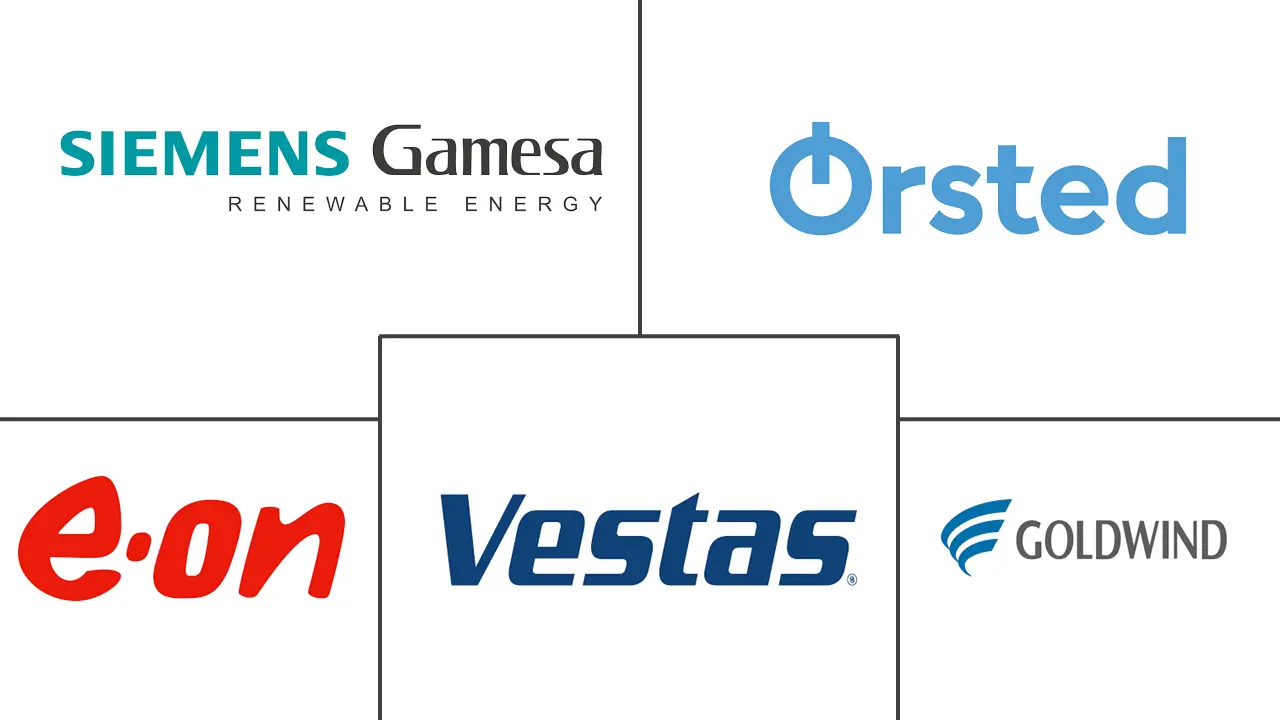
*Disclaimer: Major Players sorted in no particular order |
Offshore Wind Energy Market Analysis
The offshore wind energy market is expected to register a CAGR of over 11% during the forecast period.
- Over the medium term, factors such as favorable government policies, the increasing investment in upcoming offshore wind power projects, and the reduced cost of wind energy, which has led to increased adoption of wind energy, are expected to drive the market during the forecast period.
- On the other hand, the heavy and large equipment movement to the offshore location resulting in the high cost of the offshore wind power system is a major factor that is expected to restrain the market growth during the forecast period.
- Nevertheless, the emerging markets in Africa and South America offer a robust business opportunity for the wind power sector, as countries, including Brazil, South Africa, and Chile, are on the cusp of development, and there is an increased demand for electricity, which is expected to provide market opportunities for wind power development in the coming years.
- Europe is expected to have a significant share in the market during the forecast period, as different European countries are exploring the offshore wind energy segment.
Offshore Wind Energy Market Trends
This section covers the major market trends shaping the Offshore Wind Energy Market according to our research experts:
Floating Foundation Type to Witness Significant Growth
- As energy demand rises, major countries and companies are adopting renewable energy sources, especially wind energy, as they can provide clean energy. Adopting offshore wind energy with advanced technologies attracted many countries and companies to high investments.
- As of 2022, offshore wind turbines are usually installed in water depths of up to 40 meters and as far as 80 kilometers from shore. These turbines, rooted in the seabed by either monopile or jacket foundations, are still restricted to waters less than 50 meters deep. This is a significant limitation, as some of the largest potential markets for offshore wind, such as Japan and the United States, have only a few shallow-water sites.
- Therefore, the floating wind farm is one of the most exciting developments in ocean energy technologies. Floating foundations offer essential opportunities, like access to sites with waters deeper than 50 meters and easy turbine set-up, even for mid-depth conditions (30-50 meters). Floating offshore platforms can be built and installed in almost any marine environment. In the long term, these foundations offer a lower-cost alternative to fixed foundations.
- Floating wind energy production has taken off in Asia and Europe, leading the world in floating offshore energy, mainly from shallow waters. These foundations are entering the market as commercial projects. According to industry estimates, the technical potential for floating wind power is valued at around 7,000 GW in Europe, the United States, and Japan combined. Among the high-potential markets, Japan has set a target of 4 GW installed by 2030, followed by around 2 GW in France, the United States, and the United Kingdom, and 1 GW in Taiwan.
- At the end of 2021, 123.4 MW floating offshore wind energy projects were operating globally. Seven of those ten projects (112.9 MW) are in Europe, and three (10.5 MW) are in Asia.
- In January 2022, Repower Renewable announced its plan to build a 495 MW floating offshore wind plant in Italy with an investment of approximately USD 1.7 billion. The project is planned to feature 33 wind turbines with an individual capacity of 15 MW installed on floating foundations.
- Moreover, In May 2022, China deployed its largest floating offshore wind turbine as part of a project designed to advance the technology and demonstrate the capabilities of floating wind power generation. The floater, called Fuyao and developed by the China State Shipbuilding Corporation (CSSC's) subsidiary Haizhuang Wind Power, is equipped with a 6.2 MW typhoon-resistant wind turbine with a rotor diameter of 152 meters. The Fuyao floating platform has a total length of 236 feet, a depth of 108 feet, and a width of 262 feet. The site was chosen due to its complex seabed topography and water depths ranging between 50 and 70 meters.
- Therefore, owing to the above points, the floating foundation type segment is expected to witness significant growth in the offshore wind energy market during the forecast period.
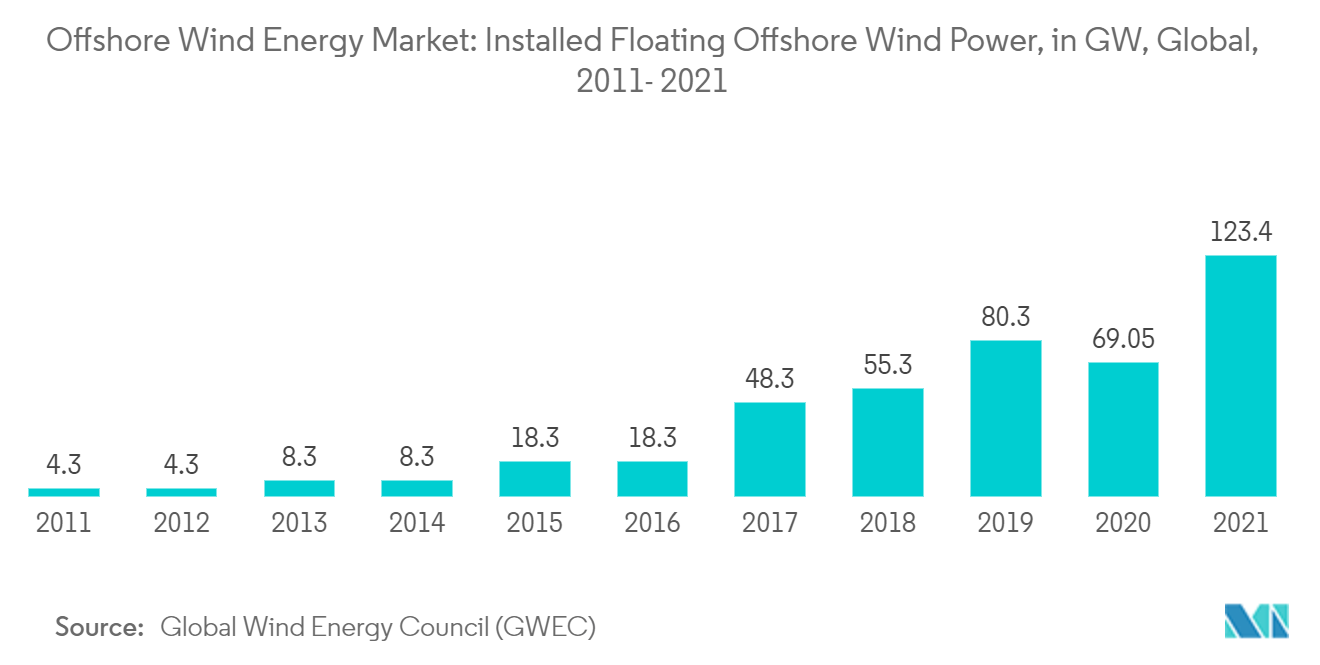
Europe to Dominate the Market
- Europe holds the highest share of offshore wind energy installations across the world. According to the European Union, Europe represents a quarter of global installations of the total offshore wind market. Thus, Europe (primarily North Sea countries) is likely to be at the helm of the offshore wind market.
- Around 85% of the total offshore wind installations are globally in European waters. The governments of the European region, particularly in the North Sea area, have set an ambitious target for installing offshore wind farms in their territorial waters.
- In 2021, Europe added 2,899 MW of offshore wind power capacity, i.e., total offshore wind energy is 27814 MW. The Netherlands 2490 MW), Belgium (2262 MW), and the United Kingdom (12700 MW) supplied this new capacity to the grid.
- In May 2022, the Government of Norway launched an investment plan to allocate sea areas for offshore wind development by 2040, targeting 30 GW of capacity. In Europe, floating offshore wind offers unique opportunities. Floating turbines can produce electricity in deeper waters and further offshore than bottom-fixed turbines. This floating technology opens up offshore wind to countries that do not have shallow water so that offshore wind can be developed in deep sea basins like the Mediterranean or Atlantic.
- In 2021, to build new wind farms in Europe, USD 48.5 billion was spent, helping to finance a record 24.6 GW of additional capacity. With a record 17.3 GW of projects changing hands as of 2021, there was also EUR 15.6 billion worth of project acquisition activity. Wind energy has been a popular investment in Europe, and the future holds enormous potential. For instance, the German government has scheduled three tender dates that will occur yearly between 2021 and 2028, with a total tender volume of almost 31 GW.
- The European Commission published a new EU strategy on offshore renewable energy under the European Green Deal. The strategy aims to install 60 GW of offshore wind projects and at least 1 GW of ocean energy by 2030. In addition, the policy aims to reach 300 GW offshore wind turbine capacity in 2050.
- Therefore, these recent trends, in turn, are expected to present Europe as an excellent business destination for players involved in the offshore wind farm business during the forecast period.
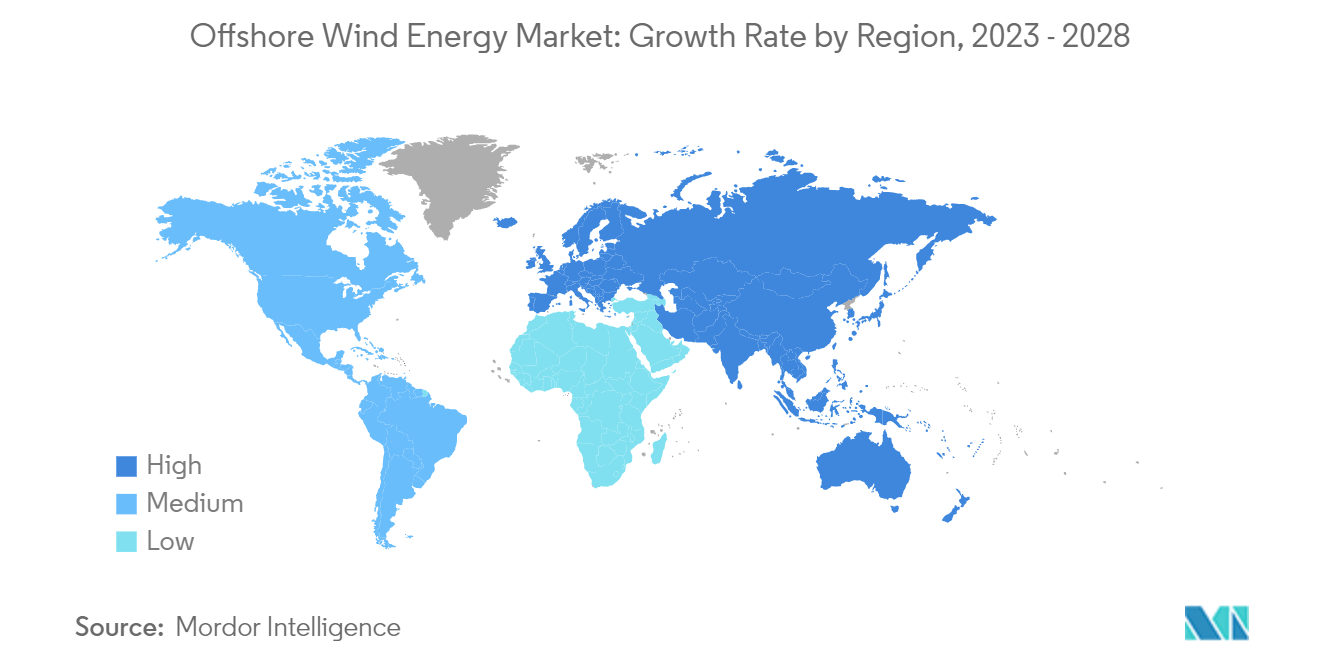
Offshore Wind Energy Industry Overview
The offshore wind energy market is moderately fragmented. The major companies market (in no particular order) include Siemens Gamesa Renewable Energy SA, Vestas Wind Systems AS, Xinjiang Goldwind Science Technology Co. Ltd, Ørsted AS, and E.ON SE., among others.
Offshore Wind Energy Market Leaders
-
Ørsted A/S
-
Vestas Wind Systems A/S
-
Siemens Gamesa Renewable Energy, S.A.,
-
E.ON SE
-
Xinjiang Goldwind Science Technology Co., Ltd.
*Disclaimer: Major Players sorted in no particular order
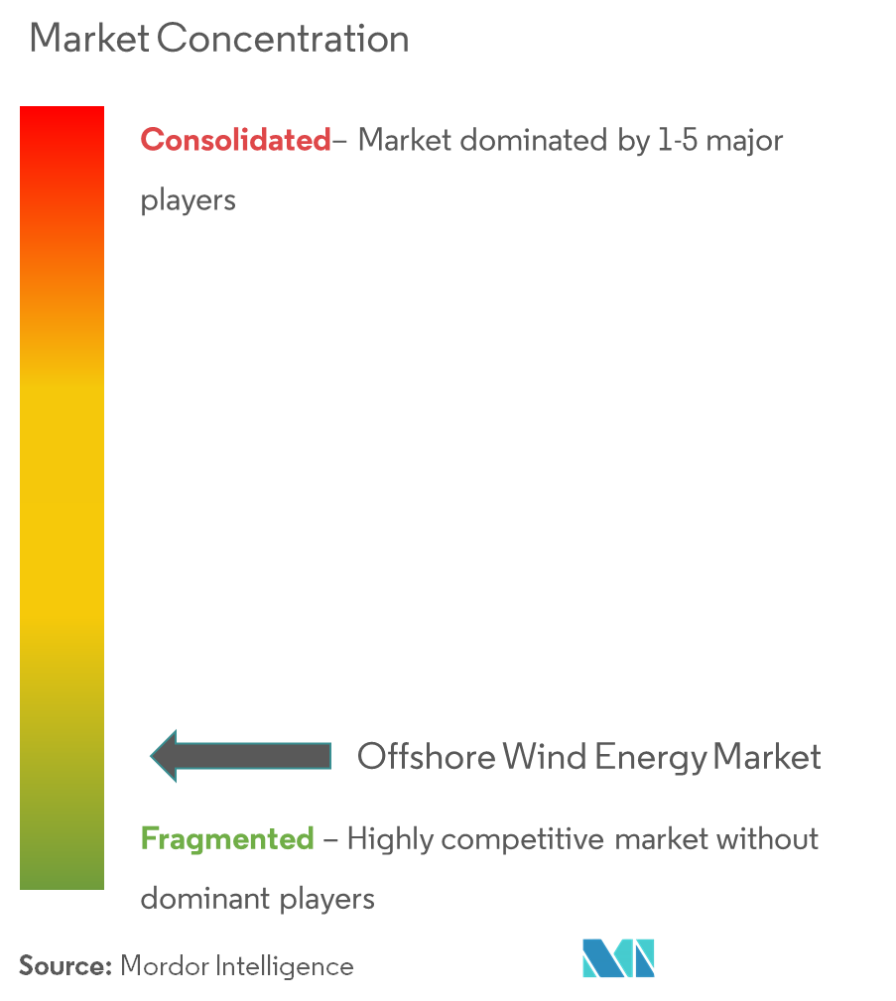
Offshore Wind Energy Market News
- In August 2022, an agreement was signed between Ping Petroleum and Cerulean Winds to work on a wind power solution for the floating production, storage, and offloading vessel (FPSO) reserved for the Avalon oil project in the UK North Sea. A large floating offshore wind turbine is likely to be connected, via a cable, to the cylindrical Sevan Hummingbird FPSO, which Ping acquired (in July 2022) from TeekayCorporation. The two companies aim to form a joint venture company with the necessary seabed lease rights to develop, deploy and operate the floating wind unit.
- In April 2022, General Electric (GE) Company was building a facility in Bergen in collaboration with cement giant Holcim and Cobod, a firm specializing in 3D printing. This is expected to enable GE Company to 3D print the bottom portion of the wind turbine towers on-site at wind farms reducing transportation costs.
Offshore Wind Energy Market Report - Table of Contents
1. INTRODUCTION
- 1.1 Scope of the Study
- 1.2 Market Definition
- 1.3 Study Assumptions
2. EXECUTIVE SUMMARY
3. RESEARCH METHODOLOGY
4. MARKET OVERVIEW
- 4.1 Introduction
- 4.2 Renewable Energy Mix, 2021
- 4.3 Offshore Wind Power Installed Capacity and Forecast in GW, till 2028
- 4.4 Major Installed Offshore Wind Farms Projects, till 2022
- 4.5 Major Upcoming Offshore Upstream Projects
- 4.6 Recent Trends and Developments
- 4.7 Government Policies and Regulations
-
4.8 Market Dynamics
- 4.8.1 Drivers
- 4.8.2 Restraints
- 4.9 Supply Chain Analysis
-
4.10 Porter's Five Forces Analysis
- 4.10.1 Bargaining Power of Suppliers
- 4.10.2 Bargaining Power of Consumers
- 4.10.3 Threat of New Entrants
- 4.10.4 Threat of Substitutes Products and Services
- 4.10.5 Intensity of Competitive Rivalry
5. MARKET SEGMENTATION
-
5.1 Foundation Type
- 5.1.1 Fixed Foundation
- 5.1.2 Floating Foundation
-
5.2 Capacity
- 5.2.1 Less Than 5 MW
- 5.2.2 Greater Than or Equal to 5 MW
-
5.3 Geography
- 5.3.1 North America
- 5.3.1.1 United States
- 5.3.1.2 Canada
- 5.3.2 Asia-Pacific
- 5.3.2.1 China
- 5.3.2.2 India
- 5.3.2.3 Japan
- 5.3.2.4 South Korea
- 5.3.2.5 Rest of Asia-Pacific
- 5.3.3 Europe
- 5.3.3.1 Germany
- 5.3.3.2 United Kingdom
- 5.3.3.3 Netherlands
- 5.3.3.4 Spain
- 5.3.3.5 Norway
- 5.3.3.6 Rest of Europe
- 5.3.4 South America
- 5.3.4.1 Brazil
- 5.3.4.2 Argentina
- 5.3.4.3 Rest of South America
- 5.3.5 Middle-East and Africa
- 5.3.5.1 Saudi Arabia
- 5.3.5.2 United Arab Emirates
- 5.3.5.3 South Africa
- 5.3.5.4 Rest of Middle-East and Africa
6. COMPETITIVE LANDSCAPE
- 6.1 Mergers and Acquisitions, Joint Ventures, Collaborations, and Agreements
- 6.2 Strategies Adopted by Leading Players
-
6.3 Company Profiles
- 6.3.1 Service Providers
- 6.3.1.1 Siemens Gamesa Renewable Energy SA
- 6.3.1.2 Vestas Wind Systems AS
- 6.3.1.3 Xinjiang Goldwind Science Technology Co. Ltd
- 6.3.1.4 General Electric Company
- 6.3.1.5 Suzlon Energy Limited
- 6.3.1.6 Nordex SE
- 6.3.2 Operators
- 6.3.2.1 Equinor ASA
- 6.3.2.2 Northland Power Inc.
- 6.3.2.3 Ørsted AS
- 6.3.2.4 EDF SA
- 6.3.2.5 E.ON SE
- *List Not Exhaustive
7. MARKET OPPORTUNITIES AND FUTURE TRENDS
** Subject To AvailablityOffshore Wind Energy Industry Segmentation
In offshore wind or offshore wind energy, wind power is produced by taking the force of the winds out at sea and converting it to electricity, which is then supplied to the distribution network on land.
The offshore wind energy market is segmented into foundation type, capacity, and geography. By foundation type, the market is segmented into fixed and floating foundations. By capacity, the market is segmented into less than 5 MW and greater than or equal to 5 MW. The report also covers the market size and forecasts for the offshore wind energy market across major regions, such as Asia-Pacific, North America, Europe, South America, the Middle East, and Africa. For each segment, the market sizing and forecasts have been done based on installed capacity (GW).
| Foundation Type | Fixed Foundation | |
| Floating Foundation | ||
| Capacity | Less Than 5 MW | |
| Greater Than or Equal to 5 MW | ||
| Geography | North America | United States |
| Canada | ||
| Geography | Asia-Pacific | China |
| India | ||
| Japan | ||
| South Korea | ||
| Rest of Asia-Pacific | ||
| Geography | Europe | Germany |
| United Kingdom | ||
| Netherlands | ||
| Spain | ||
| Norway | ||
| Rest of Europe | ||
| Geography | South America | Brazil |
| Argentina | ||
| Rest of South America | ||
| Geography | Middle-East and Africa | Saudi Arabia |
| United Arab Emirates | ||
| South Africa | ||
| Rest of Middle-East and Africa |
Offshore Wind Energy Market Research FAQs
What is the current Offshore Wind Energy Market size?
The Offshore Wind Energy Market is projected to register a CAGR of greater than 11% during the forecast period (2024-2029)
Who are the key players in Offshore Wind Energy Market?
Ørsted A/S , Vestas Wind Systems A/S, Siemens Gamesa Renewable Energy, S.A., , E.ON SE and Xinjiang Goldwind Science Technology Co., Ltd. are the major companies operating in the Offshore Wind Energy Market.
Which is the fastest growing region in Offshore Wind Energy Market?
Asia Pacific is estimated to grow at the highest CAGR over the forecast period (2024-2029).
Which region has the biggest share in Offshore Wind Energy Market?
In 2024, the Europe accounts for the largest market share in Offshore Wind Energy Market.
What years does this Offshore Wind Energy Market cover?
The report covers the Offshore Wind Energy Market historical market size for years: 2020, 2021, 2022 and 2023. The report also forecasts the Offshore Wind Energy Market size for years: 2024, 2025, 2026, 2027, 2028 and 2029.
What are the major drivers fueling the expansion of the Offshore Wind Energy Industry?
The major drivers fueling the expansion of the Offshore Wind Energy Industry are a) Growing adoption of clean energy sources, and increasing demand for electricity b) Increasing investment in upcoming offshore wind power projects, and the reduced cost of wind energy
Offshore Wind Energy Industry Report
The offshore wind energy market is experiencing significant growth, driven by increasing global investments in renewable energy and supportive government policies. Segmented by components such as turbines, support structures, and electrical infrastructure, and by depth, the market sees notable growth in shallow and transitional waters. Europe remains a dominant player with its advanced technologies and substantial investments, while the Asia Pacific region is rapidly expanding its market share, fueled by rising electricity demands. Despite challenges like high capital costs and logistical complexities associated with offshore installations, the market is poised for robust expansion as nations aim to enhance their clean energy capacities and reduce carbon footprints. For a detailed analysis of offshore wind market share, size, and revenue growth rate, refer to Mordor Intelligence™ Industry Reports, which include a market forecast outlook and historical overview. Get a comprehensive analysis by downloading a free report PDF sample and explore data on offshore wind farm companies and market trends.



